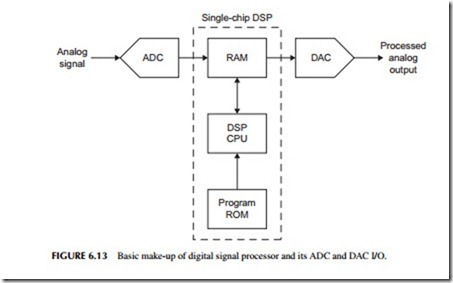DIGITAL SIGNAL PROCESSING
Digital signal processing (DSP) is the technique of programming a microcomputer to perform operations normally carried out by analog or linear circuits. The method is illustrated in Figure 6.13. Assume you want to process an analog signal by filtering. You could use a hardware filter made up of inductors and capacitors or resistors and capacitors. Another way to do it is with DSP. The analog signal to be filtered is first digitized with an ADC and the resulting data stored in a RAM. This data is then acted upon by a processor programmed to perform a filter function. Special mathematical algorithms have been developed to do this. The resulting calculations generate new data that is also stored in the RAM. This new data is then sent to a DAC where it is converted back to an analog signal. The result is that the signal is filtered as if were processed by an electronic circuit of capacitors and inductors. The processing was mathematical.
There are many other operations that can be performed by DSP. Filtering is the main application, but you can also do things like modulation and demodulation as needed in wireless applications. It will perform other things such as data compression, equalization, tone control, and even frequency analysis.
Using a program called the fast Fourier transform (FFT), the DSP can analyze a signal and tell you exactly what frequency components are in it. It identifies the harmonic frequencies and their various amplitudes and phases just as in a frequency-domain plot.
The big question is why use a complicated technique such as DSP when you can do it with simple analog/linear hardware? Probably the best answer is “just because we can.” With cheap single-chip processors, DSP is often no more expensive than an equivalent analog circuit. Since everything else is digital these days, it makes some sense to do as many analog functions digitally as well. But the best reason is that DSP provides superior results over analog methods. Filtering is substantially improved with better selectivity that was not possible with analog filters.
While DSP can be programmed on any processor or controller, it is best done on special DSP chips designed for the purpose. They use special architectures and processing schemes to speed up and improve the processing over standard conventional processors. A good example is that DSP chips implement a multiply and add or accumulate function, called MAC, that is common to most DSP processes. The MAC has to be programmed in a standard processor, but in a DSP chip it is implemented with special hardware that speeds up the process and simplifies programming. Some more conventional processors also incorporate DSP instructions to facilitate DSP operations.
Now that DSP chips are cheap despite their complexity and speed, DSP is widely used. It is found in most electronic products today, such as TV sets, cell phones, MP3 players, cable modems, and many other common products.

